Figures & data
Table 1. Participant demographics and baseline characteristics (MITT population).
Figure 1. Least-squares mean change in the severity of vaginal dryness from baseline to week 12 in the MITT population. *p < 0.05, †p < 0.01, ‡p < 0.001, §p < 0.0001 versus placebo. LS, least squares; MITT, modified intent-to-treat; SE, standard error.

Figure 2. Percentage of women who had substantial improvements (two levels or more) in severity of (A) dyspareunia and (B) vaginal dryness over 12 weeks. *p < 0.05, †p < 0.01, ‡p < 0.001 versus placebo in women with moderate to severe vaginal symptoms.



